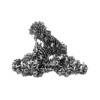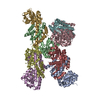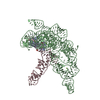+ Open data
Open data
- Basic information
Basic information
| Entry | Database: EMDB / ID: EMD-22310 | |||||||||
|---|---|---|---|---|---|---|---|---|---|---|
| Title | Secretory Immunoglobin A (SIgA) | |||||||||
 Map data Map data | sIgA map from CS2 non uniform refinement, sharpened - 3.3A | |||||||||
 Sample Sample |
| |||||||||
 Keywords Keywords | IMMUNE SYSTEM | |||||||||
| Function / homology |  Function and homology information Function and homology informationScavenging of heme from plasma / polymeric immunoglobulin receptor activity / immunoglobulin transcytosis in epithelial cells mediated by polymeric immunoglobulin receptor / polymeric immunoglobulin binding / dimeric IgA immunoglobulin complex / secretory dimeric IgA immunoglobulin complex / pentameric IgM immunoglobulin complex / monomeric IgA immunoglobulin complex / secretory IgA immunoglobulin complex / IgA binding ...Scavenging of heme from plasma / polymeric immunoglobulin receptor activity / immunoglobulin transcytosis in epithelial cells mediated by polymeric immunoglobulin receptor / polymeric immunoglobulin binding / dimeric IgA immunoglobulin complex / secretory dimeric IgA immunoglobulin complex / pentameric IgM immunoglobulin complex / monomeric IgA immunoglobulin complex / secretory IgA immunoglobulin complex / IgA binding / Cell surface interactions at the vascular wall / detection of chemical stimulus involved in sensory perception of bitter taste / glomerular filtration / phosphatidylcholine binding / peptidoglycan binding / receptor clustering / epidermal growth factor receptor binding / immunoglobulin complex, circulating / immunoglobulin receptor binding / positive regulation of respiratory burst / humoral immune response / complement activation, classical pathway / antigen binding / Neutrophil degranulation / epidermal growth factor receptor signaling pathway / recycling endosome membrane / antibacterial humoral response / single-stranded DNA binding / protein-macromolecule adaptor activity / protein-containing complex assembly / adaptive immune response / receptor complex / innate immune response / protein homodimerization activity / plasma membrane Similarity search - Function | |||||||||
| Biological species |  | |||||||||
| Method | single particle reconstruction / cryo EM / Resolution: 3.3 Å | |||||||||
 Authors Authors | Kumar Bharathkar S / Parker BP | |||||||||
| Funding support |  United States, 2 items United States, 2 items
| |||||||||
 Citation Citation |  Journal: Elife / Year: 2020 Journal: Elife / Year: 2020Title: The structures of secretory and dimeric immunoglobulin A. Authors: Sonya Kumar Bharathkar / Benjamin W Parker / Andrey G Malyutin / Nandan Haloi / Kathryn E Huey-Tubman / Emad Tajkhorshid / Beth M Stadtmueller /  Abstract: Secretory (S) Immunoglobulin (Ig) A is the predominant mucosal antibody, which binds pathogens and commensal microbes. SIgA is a polymeric antibody, typically containing two copies of IgA that ...Secretory (S) Immunoglobulin (Ig) A is the predominant mucosal antibody, which binds pathogens and commensal microbes. SIgA is a polymeric antibody, typically containing two copies of IgA that assemble with one joining-chain (JC) to form dimeric (d) IgA that is bound by the polymeric Ig-receptor ectodomain, called secretory component (SC). Here, we report the cryo-electron microscopy structures of murine SIgA and dIgA. Structures reveal two IgAs conjoined through four heavy-chain tailpieces and the JC that together form a β-sandwich-like fold. The two IgAs are bent and tilted with respect to each other, forming distinct concave and convex surfaces. In SIgA, SC is bound to one face, asymmetrically contacting both IgAs and JC. The bent and tilted arrangement of complex components limits the possible positions of both sets of antigen-binding fragments (Fabs) and preserves steric accessibility to receptor-binding sites, likely influencing antigen binding and effector functions. | |||||||||
| History |
|
- Structure visualization
Structure visualization
| Movie |
 Movie viewer Movie viewer |
|---|---|
| Structure viewer | EM map:  SurfView SurfView Molmil Molmil Jmol/JSmol Jmol/JSmol |
| Supplemental images |
- Downloads & links
Downloads & links
-EMDB archive
| Map data |  emd_22310.map.gz emd_22310.map.gz | 230.2 MB |  EMDB map data format EMDB map data format | |
|---|---|---|---|---|
| Header (meta data) |  emd-22310-v30.xml emd-22310-v30.xml emd-22310.xml emd-22310.xml | 31.1 KB 31.1 KB | Display Display |  EMDB header EMDB header |
| FSC (resolution estimation) |  emd_22310_fsc.xml emd_22310_fsc.xml | 14.3 KB | Display |  FSC data file FSC data file |
| Images |  emd_22310.png emd_22310.png | 36.6 KB | ||
| Masks |  emd_22310_msk_1.map emd_22310_msk_1.map | 244.1 MB |  Mask map Mask map | |
| Filedesc metadata |  emd-22310.cif.gz emd-22310.cif.gz | 7.4 KB | ||
| Others |  emd_22310_additional_1.map.gz emd_22310_additional_1.map.gz emd_22310_additional_2.map.gz emd_22310_additional_2.map.gz emd_22310_additional_3.map.gz emd_22310_additional_3.map.gz emd_22310_additional_4.map.gz emd_22310_additional_4.map.gz emd_22310_additional_5.map.gz emd_22310_additional_5.map.gz emd_22310_half_map_1.map.gz emd_22310_half_map_1.map.gz emd_22310_half_map_2.map.gz emd_22310_half_map_2.map.gz | 472.6 MB 410.1 MB 410.4 MB 1.1 MB 121.3 MB 226.4 MB 226.4 MB | ||
| Archive directory |  http://ftp.pdbj.org/pub/emdb/structures/EMD-22310 http://ftp.pdbj.org/pub/emdb/structures/EMD-22310 ftp://ftp.pdbj.org/pub/emdb/structures/EMD-22310 ftp://ftp.pdbj.org/pub/emdb/structures/EMD-22310 | HTTPS FTP |
-Validation report
| Summary document |  emd_22310_validation.pdf.gz emd_22310_validation.pdf.gz | 1.2 MB | Display |  EMDB validaton report EMDB validaton report |
|---|---|---|---|---|
| Full document |  emd_22310_full_validation.pdf.gz emd_22310_full_validation.pdf.gz | 1.2 MB | Display | |
| Data in XML |  emd_22310_validation.xml.gz emd_22310_validation.xml.gz | 21.9 KB | Display | |
| Data in CIF |  emd_22310_validation.cif.gz emd_22310_validation.cif.gz | 28.9 KB | Display | |
| Arichive directory |  https://ftp.pdbj.org/pub/emdb/validation_reports/EMD-22310 https://ftp.pdbj.org/pub/emdb/validation_reports/EMD-22310 ftp://ftp.pdbj.org/pub/emdb/validation_reports/EMD-22310 ftp://ftp.pdbj.org/pub/emdb/validation_reports/EMD-22310 | HTTPS FTP |
-Related structure data
| Related structure data |  7jg2MC  7jg1C C: citing same article ( M: atomic model generated by this map |
|---|---|
| Similar structure data |
- Links
Links
| EMDB pages |  EMDB (EBI/PDBe) / EMDB (EBI/PDBe) /  EMDataResource EMDataResource |
|---|---|
| Related items in Molecule of the Month |
- Map
Map
| File |  Download / File: emd_22310.map.gz / Format: CCP4 / Size: 244.1 MB / Type: IMAGE STORED AS FLOATING POINT NUMBER (4 BYTES) Download / File: emd_22310.map.gz / Format: CCP4 / Size: 244.1 MB / Type: IMAGE STORED AS FLOATING POINT NUMBER (4 BYTES) | ||||||||||||||||||||||||||||||||||||||||||||||||||||||||||||||||||||
|---|---|---|---|---|---|---|---|---|---|---|---|---|---|---|---|---|---|---|---|---|---|---|---|---|---|---|---|---|---|---|---|---|---|---|---|---|---|---|---|---|---|---|---|---|---|---|---|---|---|---|---|---|---|---|---|---|---|---|---|---|---|---|---|---|---|---|---|---|---|
| Annotation | sIgA map from CS2 non uniform refinement, sharpened - 3.3A | ||||||||||||||||||||||||||||||||||||||||||||||||||||||||||||||||||||
| Projections & slices | Image control
Images are generated by Spider. | ||||||||||||||||||||||||||||||||||||||||||||||||||||||||||||||||||||
| Voxel size | X=Y=Z: 0.652 Å | ||||||||||||||||||||||||||||||||||||||||||||||||||||||||||||||||||||
| Density |
| ||||||||||||||||||||||||||||||||||||||||||||||||||||||||||||||||||||
| Symmetry | Space group: 1 | ||||||||||||||||||||||||||||||||||||||||||||||||||||||||||||||||||||
| Details | EMDB XML:
CCP4 map header:
| ||||||||||||||||||||||||||||||||||||||||||||||||||||||||||||||||||||
-Supplemental data
-Mask #1
| File |  emd_22310_msk_1.map emd_22310_msk_1.map | ||||||||||||
|---|---|---|---|---|---|---|---|---|---|---|---|---|---|
| Projections & Slices |
| ||||||||||||
| Density Histograms |
-Additional map: sIgA EM map generated by Relion 3.X. Same...
| File | emd_22310_additional_1.map | ||||||||||||
|---|---|---|---|---|---|---|---|---|---|---|---|---|---|
| Annotation | sIgA EM map generated by Relion 3.X. Same dataset as used with cryoSparc2. | ||||||||||||
| Projections & Slices |
| ||||||||||||
| Density Histograms |
-Additional map: Half 1 map for sIgA Relion refinement
| File | emd_22310_additional_2.map | ||||||||||||
|---|---|---|---|---|---|---|---|---|---|---|---|---|---|
| Annotation | Half_1 map for sIgA Relion refinement | ||||||||||||
| Projections & Slices |
| ||||||||||||
| Density Histograms |
-Additional map: Half 2 map for sIgA Relion refinement
| File | emd_22310_additional_3.map | ||||||||||||
|---|---|---|---|---|---|---|---|---|---|---|---|---|---|
| Annotation | Half_2 map for sIgA Relion refinement | ||||||||||||
| Projections & Slices |
| ||||||||||||
| Density Histograms |
-Additional map: Mask used in Relion post-processing
| File | emd_22310_additional_4.map | ||||||||||||
|---|---|---|---|---|---|---|---|---|---|---|---|---|---|
| Annotation | Mask used in Relion post-processing | ||||||||||||
| Projections & Slices |
| ||||||||||||
| Density Histograms |
-Additional map: sIgA map from CS2 non uniform refinement, unsharpened
| File | emd_22310_additional_5.map | ||||||||||||
|---|---|---|---|---|---|---|---|---|---|---|---|---|---|
| Annotation | sIgA map from CS2 non uniform refinement, unsharpened | ||||||||||||
| Projections & Slices |
| ||||||||||||
| Density Histograms |
-Half map: Half 2 map for sIgA Non-uniform refinement job
| File | emd_22310_half_map_1.map | ||||||||||||
|---|---|---|---|---|---|---|---|---|---|---|---|---|---|
| Annotation | Half_2 map for sIgA Non-uniform refinement job | ||||||||||||
| Projections & Slices |
| ||||||||||||
| Density Histograms |
-Half map: Half 1 map for sIgA Non-uniform refinement job
| File | emd_22310_half_map_2.map | ||||||||||||
|---|---|---|---|---|---|---|---|---|---|---|---|---|---|
| Annotation | Half_1 map for sIgA Non-uniform refinement job | ||||||||||||
| Projections & Slices |
| ||||||||||||
| Density Histograms |
- Sample components
Sample components
-Entire : Secretory Immunoglobin A
| Entire | Name: Secretory Immunoglobin A |
|---|---|
| Components |
|
-Supramolecule #1: Secretory Immunoglobin A
| Supramolecule | Name: Secretory Immunoglobin A / type: complex / ID: 1 / Parent: 0 / Macromolecule list: #1-#3 |
|---|---|
| Source (natural) | Organism:  |
-Macromolecule #1: Igh protein
| Macromolecule | Name: Igh protein / type: protein_or_peptide / ID: 1 Details: Genes encoding the mus musculus IgA HC constant region and the lambda LC constant region were fused with HC and LC variable region sequences to create complete HC and LC sequences. The HC ...Details: Genes encoding the mus musculus IgA HC constant region and the lambda LC constant region were fused with HC and LC variable region sequences to create complete HC and LC sequences. The HC and LC variable region is not modeled in this structure. Since authors have chosen not to provide complete sample sequence of the HC and LC variable region the UNKs were not included in the sequence. Number of copies: 4 / Enantiomer: LEVO |
|---|---|
| Source (natural) | Organism:  |
| Molecular weight | Theoretical: 37.976891 KDa |
| Recombinant expression | Organism:  Homo sapiens (human) Homo sapiens (human) |
| Sequence | String: WGQGTLVTVS AESARNPTIY PLTLPPALSS DPVIIGCLIH DYFPSGTMNV TWGKSGKDIT TVNFPPALAS GGRYTMSSQL TLPAVECPE GESVKCSVQH DSNPVQELDV NCSGPTPPPP ITIPSCQPSL SLQRPALEDL LLGSDASITC TLNGLRNPEG A VFTWEPST ...String: WGQGTLVTVS AESARNPTIY PLTLPPALSS DPVIIGCLIH DYFPSGTMNV TWGKSGKDIT TVNFPPALAS GGRYTMSSQL TLPAVECPE GESVKCSVQH DSNPVQELDV NCSGPTPPPP ITIPSCQPSL SLQRPALEDL LLGSDASITC TLNGLRNPEG A VFTWEPST GKDAVQKKAV QNSCGCYSVS SVLPGCAERW NSGASFKCTV THPESGTLTG TIAKVTVNTF PPQVHLLPPP SE ELALNEL LSLTCLVRAF NPKEVLVRWL HGNEELSPES YLVFEPLKEP GEGATTYLVT SVLRVSAETW KQGDQYSCMV GHE ALPMNF TQKTIDRLSG KPTNVSVSVI MSEGDGICY UniProtKB: Igh protein |
-Macromolecule #2: Polymeric immunoglobulin receptor
| Macromolecule | Name: Polymeric immunoglobulin receptor / type: protein_or_peptide / ID: 2 / Number of copies: 1 / Enantiomer: LEVO |
|---|---|
| Source (natural) | Organism:  |
| Molecular weight | Theoretical: 61.257211 KDa |
| Recombinant expression | Organism:  Homo sapiens (human) Homo sapiens (human) |
| Sequence | String: KSPIFGPQEV SSIEGDSVSI TCYYPDTSVN RHTRKYWCRQ GASGMCTTLI SSNGYLSKEY SGRANLINFP ENNTFVINIE QLTQDDTGS YKCGLGTSNR GLSFDVSLEV SQVPELPSDT HVYTKDIGRN VTIECPFKRE NAPSKKSLCK KTNQSCELVI D STEKVNPS ...String: KSPIFGPQEV SSIEGDSVSI TCYYPDTSVN RHTRKYWCRQ GASGMCTTLI SSNGYLSKEY SGRANLINFP ENNTFVINIE QLTQDDTGS YKCGLGTSNR GLSFDVSLEV SQVPELPSDT HVYTKDIGRN VTIECPFKRE NAPSKKSLCK KTNQSCELVI D STEKVNPS YIGRAKLFMK GTDLTVFYVN ISHLTHNDAG LYICQAGEGP SADKKNVDLQ VLAPEPELLY KDLRSSVTFE CD LGREVAN EAKYLCRMNK ETCDVIINTL GKRDPDFEGR ILITPKDDNG RFSVLITGLR KEDAGHYQCG AHSSGLPQEG WPI QTWQLF VNEESTIPNR RSVVKGVTGG SVAIACPYNP KESSSLKYWC RWEGDGNGHC PVLVGTQAQV QEEYEGRLAL FDQP GNGTY TVILNQLTTE DAGFYWCLTN GDSRWRTTIE LQVAEATREP NLEVTPQNAT AVLGETFTVS CHYPCKFYSQ EKYWC KWSN KGCHILPSHD EGARQSSVSC DQSSQLVSMT LNPVSKEDEG WYWCGVKQGQ TYGETTAIYI AVEER UniProtKB: Polymeric immunoglobulin receptor |
-Macromolecule #3: Immunoglobulin J chain
| Macromolecule | Name: Immunoglobulin J chain / type: protein_or_peptide / ID: 3 / Number of copies: 1 / Enantiomer: LEVO |
|---|---|
| Source (natural) | Organism:  |
| Molecular weight | Theoretical: 15.637499 KDa |
| Recombinant expression | Organism:  Homo sapiens (human) Homo sapiens (human) |
| Sequence | String: DDEATILADN KCMCTRVTSR IIPSTEDPNE DIVERNIRIV VPLNNRENIS DPTSPLRRNF VYHLSDVCKK CDPVEVELED QVVTATQSN ICNEDDGVPE TCYMYDRNKC YTTMVPLRYH GETKMVQAAL TPDSCYPD UniProtKB: Immunoglobulin J chain |
-Macromolecule #7: 2-acetamido-2-deoxy-beta-D-glucopyranose
| Macromolecule | Name: 2-acetamido-2-deoxy-beta-D-glucopyranose / type: ligand / ID: 7 / Number of copies: 4 / Formula: NAG |
|---|---|
| Molecular weight | Theoretical: 221.208 Da |
| Chemical component information |  ChemComp-NAG: |
-Experimental details
-Structure determination
| Method | cryo EM |
|---|---|
 Processing Processing | single particle reconstruction |
| Aggregation state | particle |
- Sample preparation
Sample preparation
| Buffer | pH: 7.4 |
|---|---|
| Grid | Model: Quantifoil R1.2/1.3 / Material: COPPER / Mesh: 300 / Pretreatment - Type: GLOW DISCHARGE / Pretreatment - Time: 80 sec. / Pretreatment - Atmosphere: AIR / Pretreatment - Pressure: 0.039 kPa / Details: Pelco easiGlow - 20 mA current |
| Vitrification | Cryogen name: ETHANE / Chamber humidity: 100 % / Chamber temperature: 292 K / Instrument: FEI VITROBOT MARK IV Details: Wait time - 0s Drain time - 0s Blot time - 6s Blot Force - 5. |
- Electron microscopy
Electron microscopy
| Microscope | FEI TITAN KRIOS |
|---|---|
| Specialist optics | Energy filter - Name: GIF Bioquantum / Energy filter - Slit width: 20 eV |
| Image recording | Film or detector model: GATAN K3 BIOQUANTUM (6k x 4k) / Digitization - Dimensions - Width: 5760 pixel / Digitization - Dimensions - Height: 4092 pixel / Average electron dose: 60.0 e/Å2 |
| Electron beam | Acceleration voltage: 300 kV / Electron source:  FIELD EMISSION GUN FIELD EMISSION GUN |
| Electron optics | C2 aperture diameter: 100.0 µm / Calibrated magnification: 76687 / Illumination mode: FLOOD BEAM / Imaging mode: BRIGHT FIELD / Cs: 2.7 mm / Nominal magnification: 130000 |
| Sample stage | Specimen holder model: FEI TITAN KRIOS AUTOGRID HOLDER / Cooling holder cryogen: NITROGEN |
| Experimental equipment |  Model: Titan Krios / Image courtesy: FEI Company |
 Movie
Movie Controller
Controller























 Z (Sec.)
Z (Sec.) Y (Row.)
Y (Row.) X (Col.)
X (Col.)






















































































